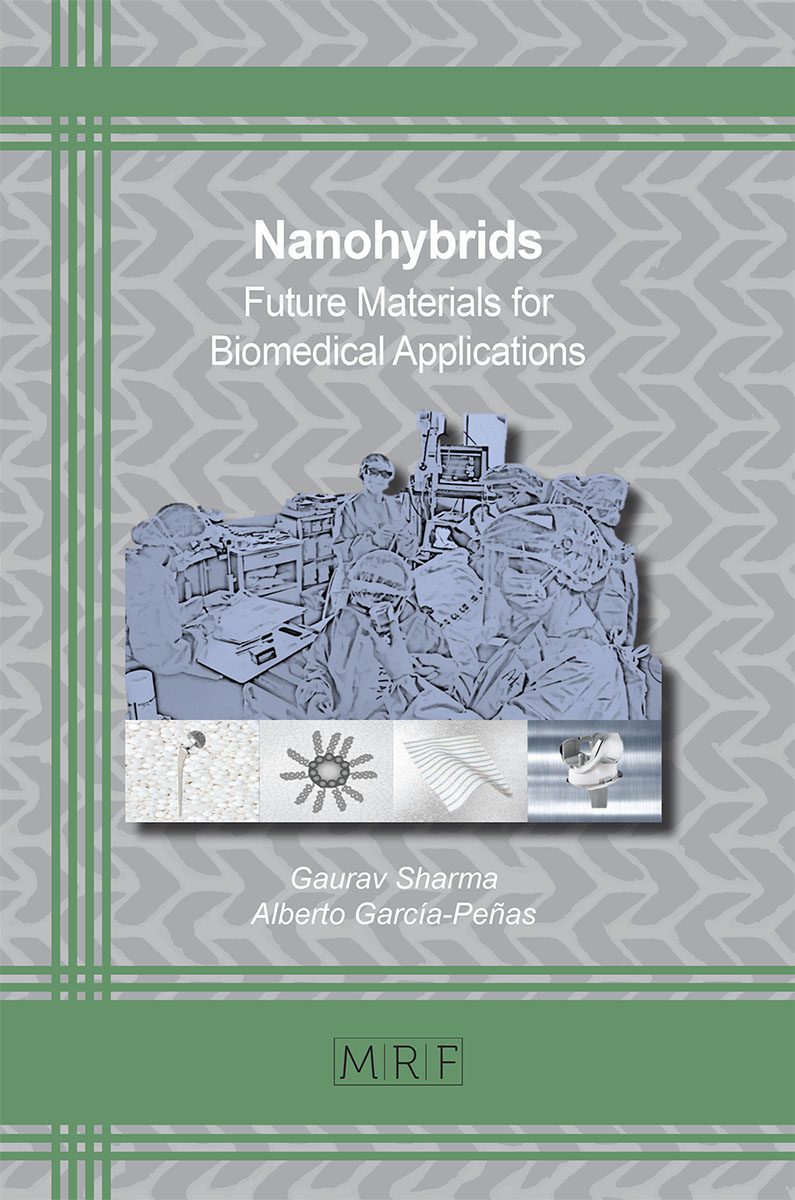Nanohybrids for Wound Healing Application
A. Saravanan, P. Senthil Kumar, R. Jayasree, S. Jeevanantham
The microfluidics-delivered nanohybrids invest the framework with an arranged course from wound discovery, receptive oxygen species rummaging and drug release. The drug release conduct mirrors the dynamic wound healing process, hence rendering an upgraded bio-mimetic regeneration. The properties of nanomaterials that are 1– 100 nm in size can be controlled to influence their capacities while connecting with biomaterials and biomedicines. Among the different sorts of nanomaterials, the clay minerals are universal in soils and viewed as protected materials for use in medicinal applications. Anti-bacterial activity is a vital factor for wound healing. Re-epithelization happens amid wound healing and includes the expansion of keratinocytes and the separation of fibroblasts. Ongoing improvements in nanotechnology for blending nanometer-estimate materials may give a chance to empowering viable wound healing because of material surface collaboration with cells and tissue.
Keywords
Nanomaterials, Wound Healing, Fibroblasts, Keratinocytes, Anti-Bacterial
Published online 11/20/2020, 13 pages
Citation: A. Saravanan, P. Senthil Kumar, R. Jayasree, S. Jeevanantham, Nanohybrids for Wound Healing Application, Materials Research Foundations, Vol. 87, pp 121-133, 2021
DOI: https://doi.org/10.21741/9781644901076-5
Part of the book on Nanohybrids
References
[1] N.B. Menke, K.R. Ward, T.M. Witten, D.G. Bonchev, R.F. Diegelmann, Impaired wound healing, Clinics in Dermatology, 25 (2007) 19-25. https://doi.org/10.1016/j.clindermatol.2006.12.005
[2] A. Bhatia, K. O’Brien, M. Chen, A. Wong, W. Garner, D.T. Woodley, W. Li, Dual therapeutic functions of F-5 fragment in burn wounds: preventing wound progression and promoting wound healing in pigs, Molecular Therapy – Methods & Clinical Development, 3 (2016) 16041. https://doi.org/10.1038/mtm.2016.41
[3] Z. Hussain, H.E. Thu, S.-F. Ng, S. Khan, H. Katas, Nanoencapsulation, an efficient and promising approach to maximize wound healing efficacy of curcumin: A review of new trends and state-of-the-art, Colloids and Surfaces B: Biointerfaces, 150 (2017) 223-241. https://doi.org/10.1016/j.colsurfb.2016.11.036
[4] M. Moritz, M. Geszke-Moritz, The newest achievements in synthesis, immobilization and practical applications of antibacterial nanoparticles, Chemical Engineering Journal, 228 (2013) 596–613. https://doi.org/10.1016/j.cej.2013.05.046
[5] S.S. Mirtalebi, H. Almasi, M.A. Khaledabad, Physical, morphological, antimicrobial and release properties of novel MgO-bacterial cellulose nanohybrids prepared by in-situ and ex-situ methods, International Journal of Biological Macromolecules, 128 (2019) 848-857. https://doi.org/10.1016/j.ijbiomac.2019.02.007
[6] M. Kuhlmann, W. Wigger-Alberti, Y.V. Mackensen, M. Ebbinghaus, R. Williams, F. Krause-Kyora, R. Wolber, Wound healing characteristics of a novel wound healing ointment in an abrasive wound model: a randomised, intra-individual clinical investigation, Wound Medicine, 24 (2019) 24-32. https://doi.org/10.1016/j.wndm.2019.02.002
[7] S. Guo, L.A. DiPietro, Factors Affecting Wound Healing, Journal of Dental Research, 89 (2010) 219–229. https://doi.org/10.1177/0022034509359125
[8] Z. Hussain, H. Katas, M.C.I.M. Amin, E. Kumolosasi, S. Sahudin, Downregulation of immunological mediators in 2,4-dinitrofluorobenzene-induced atopic dermatitis-like skin lesions by hydrocortisone-loaded chitosan nanoparticles, International Journal of Nanomedicine, 9 (2014) 5143–5156. https://doi.org/10.2147/IJN.S71543
[9] M. Ranjbar-Mohammadi, S.H. Bahrami, Electrospun curcumin loaded poly(ε caprolactone)/gum tragacanth nanofibers for biomedical application, International Journal of Biological Macromolecules, 84 (2016) 448–456. https://doi.org/10.1016/j.ijbiomac.2015.12.024
[10] A.E. Krausz, B.L. Adler, V. Cabral, M. Navati, J. Doerner, R.A. Charafeddine, D. Chandra, H. Liang, L. Gunther, A. Clendaniel, S. Harper, J.M. Friedman, J.D. Nosanchuk, A.J. Friedman, Curcumin-encapsulated nanoparticles as innovative antimicrobial and wound healing agent, Nanomedicine: Nanotechnology, Biology and Medicine, 11 (2015) 195–206. https://doi.org/10.1016/j.nano.2014.09.004
[11] C. Gong, Q. Wu, Y. Wang, D. Zhang, F. Luo, X. Zhao, Y. Wei, Z. Qian, A biodegradable hydrogel system containing curcumin encapsulated in micelles for cutaneous wound healing, Biomaterials, 34 (2013) 6377–6387. https://doi.org/10.1016/j.biomaterials.2013.05.005
[12] E. Dellera, M.C. Bonferoni, G. Sandri, S. Rossi, F. Ferrari, C. Del Fante, C. Perotti, P. Grisoli, C. Caramella, Development of chitosan oleate ionic micelles loaded with silver sulfadiazine to be associated with platelet lysate for application in wound healing, European Journal of Pharmaceutics and Biopharmaceutics, 88 (2014) 643–650. https://doi.org/10.1016/j.ejpb.2014.07.015
[13] V.V.S.R. Karri, G. Kuppusamy, S.V. Talluri, S.S. Mannemala, R. Kollipara, A.D. Wadhwani, S. Mulukutla, K.R.S. Raju, R. Malayandi, Curcumin loaded chitosan nanoparticles impregnated into collagen-alginate scaffolds for diabetic wound healing, International Journal of Biological Macromolecules, 93 (2016) 1519–1529. https://doi.org/10.1016/j.ijbiomac.2016.05.038
[14] X. Li, S. Chen, B. Zhang, M. Li, K. Diao, Z. Zhang, J. Li, Y. Xu, X. Wang, H. Chen, In situ injectable nanocomposite hydrogel composed of curcumin, N, Ocarboxymethyl chitosan and oxidized alginate for wound healing application, International Journal of Pharmaceutics, 437 (2012) 110–119. https://doi.org/10.1016/j.ijpharm.2012.08.001
[15] J.Y. Kim, J.H. Yang, J.H. Lee, G. Choi, M.R. Jo, S.J. Choi, J.H. Choy, 2D inorganic-antimalaria drug–polymer hybrid with pH-responsive solubility, Chemistry: An Asian Journal, 10 (2015) 2264–2271. https://doi.org/10.1002/asia.201500347
[16] Z. Qiao, M. Shen, Y. Xiao, M. Zhu, S. Mignani, J.P. Majoral, X. Shi, Organic/inorganic nanohybrids formed using electrospun polymer nanofibers as nanoreactors, Coordination Chemistry Reviews, 372 (2018) 31–51. https://doi.org/10.1016/j.ccr.2018.06.001
[17] B. Marta, M. Potara, M. Iliut, E. Jakab, T. Radu, F. Imre-Lucaci, G. Katona, O. Popescu, S. Astilean, Designing chitosan–silver nanoparticles–graphene oxide nanohybrids with enhanced antibacterial activity against Staphylococcus aureus, Colloids and Surfaces A: Physicochemical and Engineering Aspects, 487 (2015) 113–120. https://doi.org/10.1016/j.colsurfa.2015.09.046
































